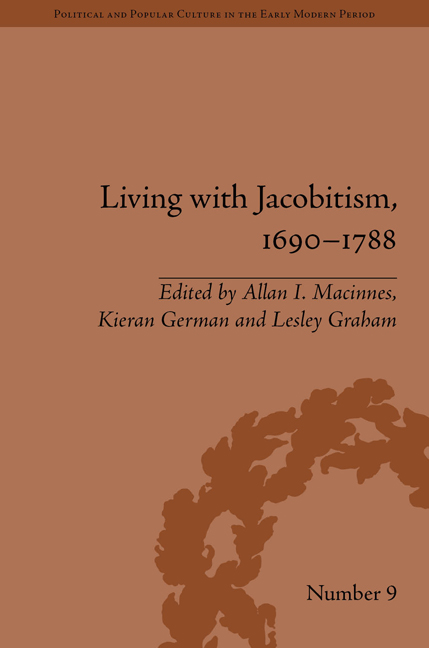Book contents
- Frontmatter
- CONTENTS
- List of Contributors
- List of Figures
- Abbreviations
- Preface: Breandán Ó Buachalla, A Tribute
- Introduction: Living with Jacobitism
- 1 The First Jacobite and the Scottish Parliament
- 2 The Scottish Jacobite Community at Saint-Germain after the Departure of the Stuart Court
- 3 Liturgy: The Sacramental Soul of Jacobitism
- 4 ‘Zealous in the Defence of the Protestant Religion and Liberty’: The Making of Whig Scotland, c. 1688–c. 1746
- 5 Jonathan Swift's Memoirs of a Jacobite
- 6 ‘Female Rebels’: The Female Figure in Anti-Jacobite Propaganda
- 7 Commerce and the Jacobite Court: Scottish Migrants in France,1688–1718
- 8 Ultramontane Ultras: The Intellectual Character of Irish Students at the University of Paris
- 9 To a Fair Meeting on the Green: The Order of Toboso and Jacobite Fraternalism, 1726–c. 1739
- 10 English and Scottish Jacobite Painters in Eighteenth-Century Rome
- 11 Polite War: Material Culture of the Jacobite Era, 1688–1760
- 12 Robert Adam: ‘My Mother's Dear British Boy’
- 13 From Jacobite to Jacobin: Robert Watson's Life in Opposition
- 14 Robert Louis Stevenson's ‘The Young Chevalier’: Unimagined Space
- Notes
- Index
10 - English and Scottish Jacobite Painters in Eighteenth-Century Rome
- Frontmatter
- CONTENTS
- List of Contributors
- List of Figures
- Abbreviations
- Preface: Breandán Ó Buachalla, A Tribute
- Introduction: Living with Jacobitism
- 1 The First Jacobite and the Scottish Parliament
- 2 The Scottish Jacobite Community at Saint-Germain after the Departure of the Stuart Court
- 3 Liturgy: The Sacramental Soul of Jacobitism
- 4 ‘Zealous in the Defence of the Protestant Religion and Liberty’: The Making of Whig Scotland, c. 1688–c. 1746
- 5 Jonathan Swift's Memoirs of a Jacobite
- 6 ‘Female Rebels’: The Female Figure in Anti-Jacobite Propaganda
- 7 Commerce and the Jacobite Court: Scottish Migrants in France,1688–1718
- 8 Ultramontane Ultras: The Intellectual Character of Irish Students at the University of Paris
- 9 To a Fair Meeting on the Green: The Order of Toboso and Jacobite Fraternalism, 1726–c. 1739
- 10 English and Scottish Jacobite Painters in Eighteenth-Century Rome
- 11 Polite War: Material Culture of the Jacobite Era, 1688–1760
- 12 Robert Adam: ‘My Mother's Dear British Boy’
- 13 From Jacobite to Jacobin: Robert Watson's Life in Opposition
- 14 Robert Louis Stevenson's ‘The Young Chevalier’: Unimagined Space
- Notes
- Index
Summary
The Royal of House of Stuart has been the subject matter of numerous paintings. The tragic deaths of Mary Queen of Scots and of Charles I as well as Charles Edward Stuart's failed attempt to regain the British throne greatly inspired nineteenth-century painters. Indeed, Roy Strong has shown that – along with Lady Jane Grey, Charles I and Charles II – James II and VII and Charles Edward Stuart are the figures in British history who were the most depicted by Victorian painters. The engraved and painted portraits of the Stuarts in exile have received considerable attention from scholars in recent years and have generated debates among Jacobite specialists. In 2008, a pastel portrait by the French artist Maurice Quentin de La Tour became the subject of controversy. The sitter for this portrait, which has hung in the Scottish National Portrait Gallery since its purchase in 1994, had been identified by the gallery's curators and Edward Corp as Prince Charles Edward Stuart. This iconic portrait was the most widely circulated image of Prince Charles Edward, but a London expert had no hesitation in claiming that the pastel shows Prince Henry Benedict Stuart rather than his elder brother Prince Charles Edward. The row over the sitter’s identity asted about two years and began with the publication of an article in the British Art Journal by Bendor Grosvernor, a director of Philip Mould & Company the specialist art dealers, who was able to identify the sitter of the pastel as Prince Henry Benedict by comparing this picture with a portrait of an unknown cardinal by an artist from the studio of Louis-Gabriel Blanchet.
- Type
- Chapter
- Information
- Living with Jacobitism, 1690–1788The Three Kingdoms and Beyond, pp. 139 - 152Publisher: Pickering & ChattoFirst published in: 2014



